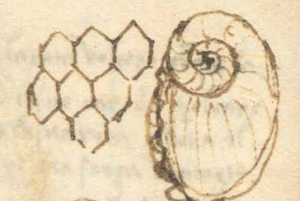 |
| The sketch of Palaeodictyon Ii Leonardo da Vinci's Paris Manuscript I |
A page of da Vinci's Paris Manuscript I concerns itself with drawings of a marine fossil composed of a honeycomb-like mesh of hexagons. Dr Mark McMenamin from the Mount Hollyoke College, Massachusetts, believes that they may be the remains of burrows made by a creature called Palaeodictyon around 540 million years ago.
 |
| The fossils of Palaeodictyon |
He noticed that the structures were cut through a series of organic pellets that were far too large to have been made by the maker of the burrows. McMenamin believes that, like modern day bees, the eggs were deposited and then the pellets used to build up a nest around them.
When the eggs hatched, the creatures chewed their way out through the organic pellets. 'I noticed that the smaller micro-burrows tended to cluster in the centre of the swarms,' said McMenamin. He suggests that as the animals matured they moved outwards from the centre into larger burrows, until as adults they were able to live outside the nest. If he is right, then this pushes the behaviour of parenting back by 200 million years.
Their age places them right on the edge of the Cambrian and so his hypothesis is controversial. The narrow nature of the structures means that they were probably only inhabited for a small amount of time. An explanation as to why there were no fossils of the creature found with the burrows. It is incredible to think that such a massive leap 'forward' (on account of the date) could come from a text by Leonardo da Vinci over 250 years before palaeontology was recognised.